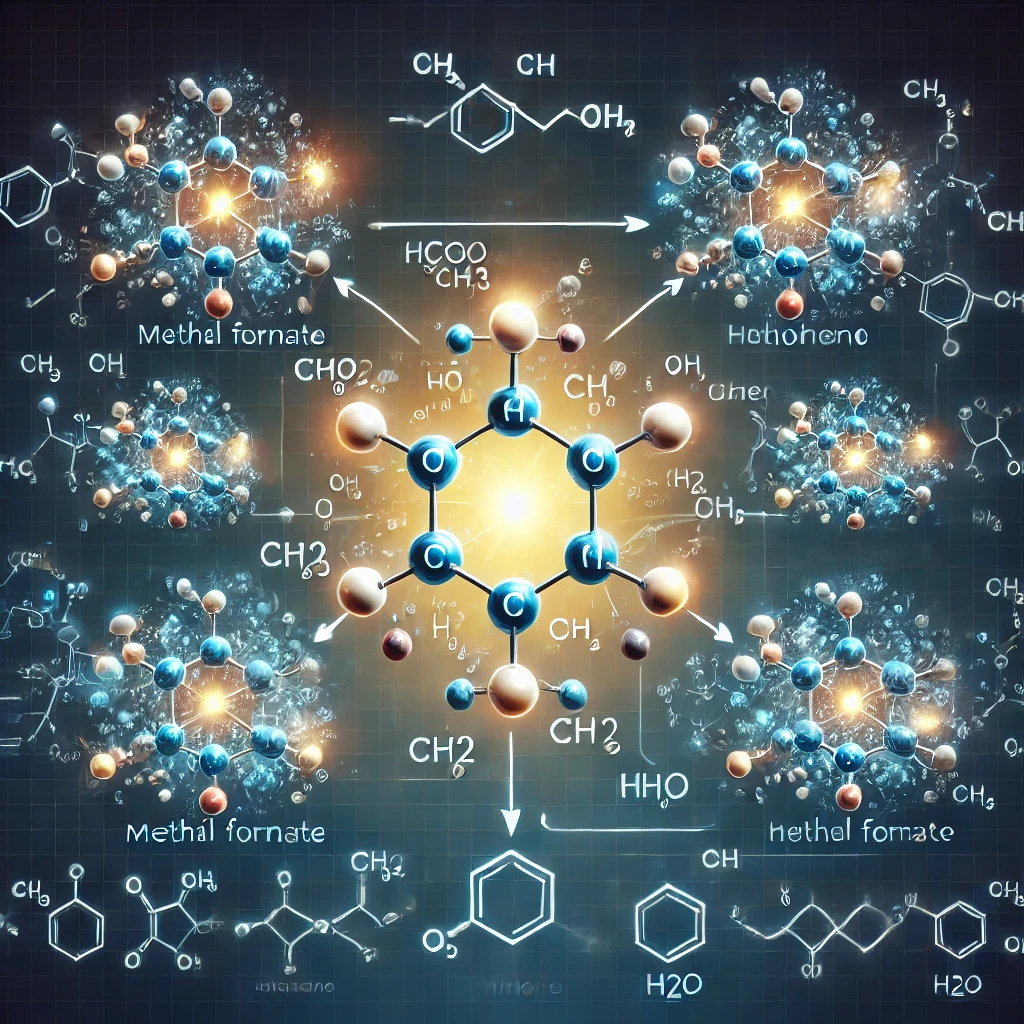
Introduction
This guide will look primarily at the chemical reactions involving methyl formate (HCOOCH₃), methylene groups (CH₂), and water (H₂O), reviewing the properties, reaction mechanisms, and applications of methyl formate to give a sound understanding of such interactions. The very first important concept in chemistry deals with the mutual interactions between different compounds, especially in terms of their theoretical basis and industrial applicability.
Understanding the interactions of different chemical compounds is essential both in the academic environment and in industrial applications. This extensive guide deals with the chemical reactions that include methyl formate (HCOOCH), methylene groups (CH₂), and water (H₂O) throughout their mechanisms, applications, and safety aspects.
Properties of HCOOCH₃
Methyl formate, whose formula is HCOOCH₃, is a simple ester, somewhat related to formic acid and methanol. Found to be a colorless liquid with a pleasant, fruity odor, methyl formate is a solvent for various industrial operations. Its high volatility and reactivity make it a highly important intermediate in organic synthesis.
Significance of CH₂ in Organic Chemistry
The methylene group (CH₂) forms the basis for organic chemistry, a group of two valences that directly bridges other hydrogens of carbon in the molecule. Due to its positioning between other atoms within a molecule, this generates a profound effect on its reactivity and other properties. Methylene groups have synergy with many chemical processes like polymerization, and this makes them a major player in the process by which very complex organic compounds can be synthesized.
Significance of Water in Chemical Reactions
Water, referred to as “the universal solvent,” then goes about the process of dissolving almost anything that can possibly be used in chemical reactions. In chemical reactions, water can play the roles of solvent, reactant, or product. With its polar nature, it permits and facilitates a variety of reactive interactions, thus making it indispensable in industrial and laboratory chemical processes.
Hydrolysis of Methyl Formate
One of the principal reactions of methyl formate is hydrolysis, wherein it reacts with water to give formic acid (HCOOH) and methanol (CH₃OH). The hydrolysis reaction proceeds either under acidic or basic conditions, with each path following a different mechanism.
Acidic Hydrolysis:
In acidic hydrolysis, the hydroxyl group on the ring is protonated, where the increased electrophilicity of the carbonyl carbon makes it a better reactant. The reaction of nucleophilic substitution thus forms tetrahedral intermediates upon attack of a nucleophile like water. This generates an onward flow in steps leading to the cuts of the ester bond to provide formic acid and methanol.
Basic Hydrolysis:
Hydroxide ions in the basic medium attack the carbonyl carbon directly to form a tetrahedral intermediate, which then leads to the cleavage of the ester bond and the formation of formate ions and methanol. Direct reaction of the formate ions with water results in formic acid.
Formation of Methyl Formate
Methyl formate is synthesized by the esterification of formic acid with methanol. This reaction usually requires an acid catalyst and the absence of water in order to shift the reaction to the right to yield esters. Methyl formate is largely produced industrially by reacting methanol and carbon monoxide in the presence of a strong base, a method called carbonylation.
The CH₂ Group Reactions
Methylene groups are engaged in several chemical reactions, such as:
Addition Reactions:
CH₂ groups can introduce addition reactions by interacting with unsaturated species to create larger molecules. Thus, methylene can add on alkenes to give rise to cyclopropane derivatives.
Polymerization Processes:
In polymer chemistry, methylene groups constitute the backbone of a polymer. As a consequence of chain-growth polymerization, methylene units are joined to one another to produce very long-chain polymers used in plastics or other materials.
Interaction Between HCOOCH₃ and CH₂
Direct reactions between methyl formate and isolated methylene groups are rarer, although specific conditions often allow some sort of interaction for the methylene group of a larger molecule with methyl formate. Such interactions are often exploited in organic synthesis to produce complex molecular architectures.
Industrial Applications
Reactions of HCOOCH₃, CH₂, and H₂O are industrially quite relevant.
From Formic Acid and Methanol-Production:
Methyl formate hydrolysis constitutes one of the most efficient ways to produce formic acid and methanol, a strategy of great industrial utility.
In Pharmaceuticals and Agriculture:
Methyl formate is utilized as an intermediate in medicines and agrochemicals synthesis as its reactivity allows formyl group addition in organic molecules, leading to a wide range of compounds overview.
Environmental Effects
It is massively important to know the environment’s behaviour of these chemicals:
Natural Ecosystem Degradation Mechanisms:
In the presence of water, methyl formate hydrolyzes and eventually breaks down into formic acid and methanol. Methyl esters produced are then natural products, thereby reducing persistence in natural ecosystems.
Protocols of Handling and Safety:
As methyl formate is a highly flammable chemical, all necessary precautions must be taken to limit its environmental effects; another point is to avoid the contamination of the surroundings by following proper safety protocols.
Safety
Safety is the utmost concern while using these chemicals:
Toxicity and Flammability:
Methyl formate is combustible and, upon inhalation or ingestion, may prove to be poisonous. Formic acid is caustic, while methanol is both toxic and combustible. Pending risk evaluation and more safety control, full-coverage regulation is required.
Proper Storage and Handling:
Safe storage of these chemicals into proper containers, away from ignition sources, and following regulatory guidelines should be ensured.
Conclusion
The reaction mechanisms of methyl formate, methylene groups, and water should be studied in academia and the industry for their potential utility. Processes such as esterification, hydrolysis, and polymerization are driven by these interactions to provide valuable chemicals, pharmaceuticals, and industrial materials. Given some of the toxicity and flammability issues raised, it is vital to ensure these substances are handled with care so that any associated risk is minimized.
As organic chemistry continues to progress as a field, many more reaction mechanisms and industrial applications involving these compounds would likely emerge. Their importance is everywhere-synthetic chemistry, material science, or environmental studies.






